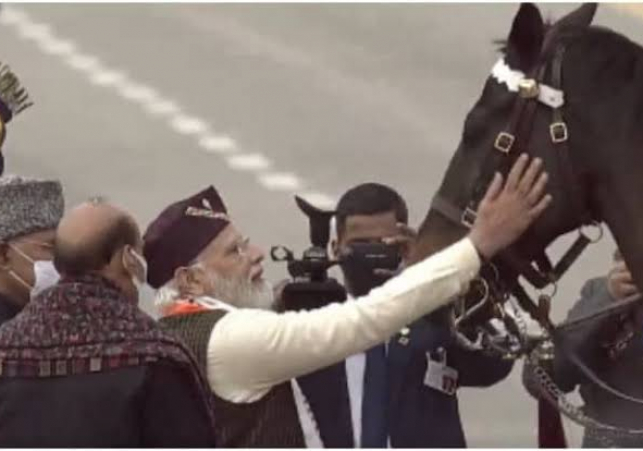

President Ram Nath Kovind, Prime Minister Narendra Modi, and Defence Minister Rajnath Singh spent a few minutes with a majestic horse that has always been a part of the iconic march for over a decade before departing at the end of the Republic Day ceremony.
Virat, the beautiful mount and a vital part of the President’s Bodyguard — an elite Army unit – attended the 73rd Republic Day parade for the 13th and final time.
In 2003, the Hanoverian breed horse joined the family of bodyguards. He is also known as the President’s bodyguard’s “Charger.”
The horse, which was inducted into the PBG on September 12, 2000, has served as the Commandant’s Charger for more than a decade. Virat was mounted by Col Anup Tiwari, the Commandant of the President Bodyguard, who rode to the right of the President’s automobile on his most recent appearance.
Virat, a Hanoverian breed, received the Chief of Army Staff’s commendation on Army Day 2022, making him the first charger horse in the PBG to gain such an honour.
“For more than a decade, he served as the Commandant’s Charger, astonished audiences, including international guests, with his usual poise and confidence. “He showed the aptitude and disposition to be the most dependable parade horse,” an officer said.
Despite his advanced age, Virat Kohli performed admirably during the Republic Day procession and Beating Retreat event last year.
President Ram Nath Kovind praised the horse on several occasions for his outstanding performance in mounted ceremonial and equestrian sports.
Virat and 200 other horses accompanied the President to Rajpath on Wednesday, then returned with other military, escorts, and cars to Rashtrapati Bhavan.
The ceremonial procession is led by horses that must be at least 15.5 hands tall, according to officials. Remount Veterinary Corps breeds the horses, which are cared for by 44 Military Veterinary Hospital.
President Ram Nath Kovind Bodyguard –
The President’s Bodyguard (PBG) is an Indian Army special family cavalry regiment. In the Indian Army’s order of precedence of units, it is the senior-most regiment. The President’s Bodyguard’s principal mission is to accompany and defend the President of India, which is why the regiment is stationed at Rashtrapati Bhavan in New Delhi, India. It is a mounted force with horses for ceremonial purposes at the presidential palace and BTR-80 battle vehicles. The regiment’s personnel are also trained as paratroopers, and they are expected to serve as pathfinders in airborne assaults. The regiment is the British Raj’s successor to the Governor General’s Bodyguard.
History of Cavalry Regiment Horse -
The Indian Army’s 61st Cavalry Regiment is a horse-mounted cavalry force. It is noteworthy for being one of the world’s largest and last active unmechanized horse-mounted cavalry battalions. Formerly used in active combat, the 61st Cavalry is now only used for ceremonial purposes, though it can be used for internal security or law enforcement if necessary. Every year on Republic Day, the 61st Cavalry and the President’s Bodyguard parade in full dress uniform in New Delhi, in what is perhaps the world’s largest assembly of traditional cavalry.
The President’s Body Guard and other regiments that had been part of the Imperial Service State Forces, provided by the Indian Princely States, were the only mounted cavalry formations in service when India gained independence in 1947. The remaining horsed cavalry regiments were restructured and reconstructed into the Gwalior Lancers, the Jodhpur/Kachhawa Horse, the Mysore Lancers, and B Squadron, 2nd Patiala Lancers after the State Forces were integrated into the regular Indian Army in 1951. The decision was made in May 1953 to combine these independent horsed cavalry units into a single regiment. The “New Horsed Cavalry Regiment” was founded on October 1, 1953, at Gwalior, with Lieutenant Colonel Phulel Singh of the Jammu and Kashmir State Forces as its first Commander.